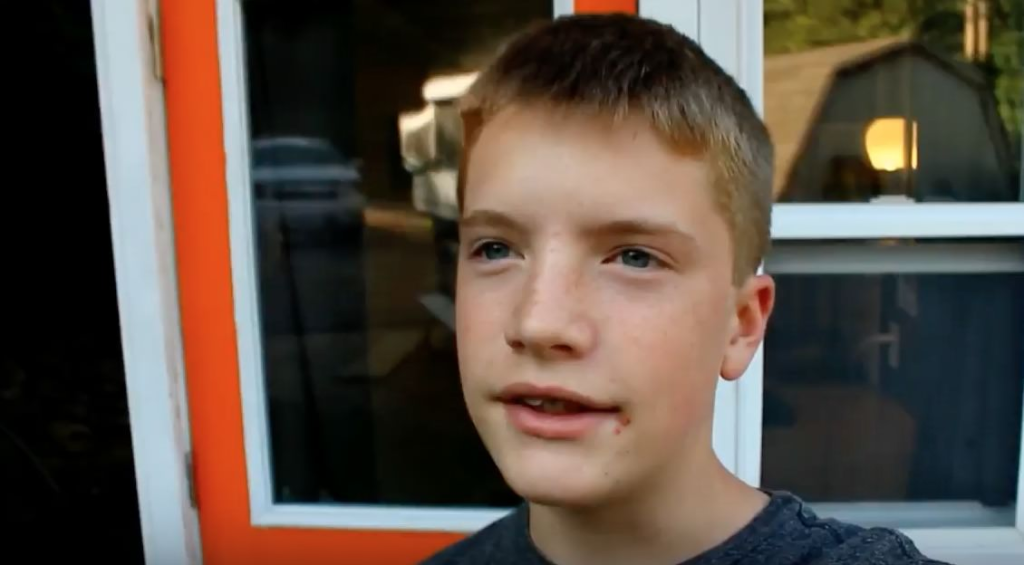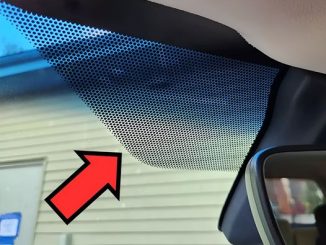Most middle schoolers probably have other things on their minds besides building houses.
But Luke Thill, a 13-year-old from Dubuque, Iowa, is unlike any other middle schooler you’ve seen before.
This talented and proactive boy has crafted his very own little house — in his parent’s backyard.
The project cost him roughly $1,500 USD — and now Luke is living his dream in his little cottage.
Come on in and have a look at what it looks like inside.
I think it’s safe to say that Luke is not like many of his 13-year-old peers. In a time of iPads, smartphones, gadgets, and X-Boxes, this young man decided to keep himself busy in a different and more ‘old-fashioned’ way. As he explains on his YouTube channel, his desire to build a small house grew out of feeling bored last summer.
After some thorough research, Luke had a pretty good idea of how he was going to put his plan into action.

The Process
It took him about a year to get the money and materials he needed to build the house. Luke mowed lawns, started a fund-raiser online, and ran errands for anyone who needed help in the neighborhood to make money.
An electrician Luke was friends with helped him install the electricity in exchange for Luke cleaning his garage out, for instance.
Luke used about 75 percent recycled material, many of which were things left over from his grandma’s house. The front door of the house was a gift from an uncle’s friend.
The 89-square-foot house is 10 feet long and 5 1/2 feet wide, with electricity but no plumbing, so no water or bathroom… yet.
“I liked the minimalism,” he told The Des Moines Register. “And I wanted to have a house without a huge mortgage.”
Luke has made several video clips and posted them online, where he talks about his project as many have grown curious about the little house.

As you can imagine, Luke also received some help from his parents, both financially and with the building itself.
But dad Greg made sure that it would be Luke himself who would pay for most of his project and also build most of it himself.
“It was a chance for a kid to do something more than play video games or sports,” Greg told The Des Moines Register. “It teaches life lessons.”
Teenager’s Dream
The house is in many ways a teenager’s dream, an oasis where you can chill and hang out in. It has a microwave, a TV, and a loft with a bed.
There’s even a barbecue and flowers at the back.
Luke usually does his homework after school at his new house and some nights during the week he gets to sleep there.
Luke already has aspirations to build another house — one that’s a little bigger for when he starts college. He also hopes to inspire others to follow their dreams:
“I want to show kids it’s possible to build at this age,” he says in one of his videos.
You can really see how proud he is about his project below.
Luke’s story is a great example of what a child can achieve with a clear goal, a strong worth ethic, and support from home.
When we broke up, my ex sent me this picture. What does it mean
Breakups can be messy, emotional, and sometimes downright confusing. But what happens when your ex sends you a cryptic picture after you call it quits? Recently, one viral image of a shovel in cement next to a blue plastic drum has sparked countless questions and plenty of speculation. At first glance, it seems like a bizarre thing to send someone, especially after a breakup. So, what does it actually mean?
Understanding the Context: A Picture Says a Thousand Words

When emotions run high after a breakup, people often communicate in unconventional ways. Some use words, others turn to silence, and a few send cryptic pictures, like this one of cement and a blue drum. On the surface, this image might appear humorous, but its underlying meaning could range from lighthearted banter to something more unsettling.
This type of message often works as a meme, exaggerating feelings of frustration, heartbreak, or bitterness. It’s not uncommon for exes to use humor as a coping mechanism, and sending a strange or symbolic image is one way to lighten the mood (or confuse the recipient). However, this particular image has darker undertones that demand a closer look.
Breaking Down the Symbolism of Cement and Blue Drums
So, why these objects? Both the cement and the blue drum are highly symbolic, making this image thought-provoking. Let’s break it down:
- Cement as a Metaphor for Finality
Cement, once set, is permanent. This could symbolize a relationship that has reached an unchangeable, irreversible end. Your ex might be saying, “This is done, and there’s no going back.” Alternatively, it could represent the emotional heaviness or “hardening” of feelings after the breakup. - The Blue Drum: A Container of Secrets or Emotions
A blue plastic drum is often associated with containment—whether it’s storing something valuable, something hazardous, or even something humorous in a meme-worthy way. It might imply that your ex is bottling up emotions or, on a darker note, trying to make you think about what could be hidden within it.
Combined, these two objects create a visual story that can swing between humor and sinister vibes, depending on the context of your relationship.
The Role of Humor in Breakups: Harmless or Hurtful?
Let’s face it—breakups are tough. Humor often becomes a coping mechanism, a way to process pain or awkwardness. Sending a picture like this might simply be a way for your ex to inject levity into a heavy situation. It could mean they’re trying to say, “Yeah, this sucks, but let’s laugh about it.”
But, on the flip side, not everyone interprets humor in the same way. What might seem like a harmless joke to one person could feel like a veiled threat to another. In today’s age of viral memes and dark humor, the line between funny and unsettling can get blurry.
Is There a Darker Side to This Gesture?
For those who feel uneasy receiving a message like this, it’s not unreasonable to wonder if there’s a more menacing undertone. With popular media showcasing stories of crime and revenge, it’s easy for the mind to wander toward worst-case scenarios. The pairing of cement and a drum has, unfortunately, been tied to grim stories in the past, giving the image a potentially sinister edge.
While this is likely just a joke, context is everything. How did your relationship end? Was it amicable, or was there tension? Your ex’s intentions could range from harmless humor to an attempt to unnerve you.
What Should You Do If You Receive a Cryptic Message Like This?
So, what’s the best course of action if your ex sends you a picture like this? Here are a few tips:
- Don’t Jump to Conclusions
Before panicking, try to think about your ex’s personality. Are they the type to make dark jokes? Have they sent memes or strange messages before? Context matters, so take a moment to evaluate the intent behind the image. - Communicate Directly
If you’re confused or concerned, ask them what they meant. A simple, “What’s this supposed to mean?” can clear up any misunderstandings. They might laugh it off and explain it was just a joke. - Trust Your Instincts
If something about the image doesn’t sit right with you, trust your gut. While it’s probably harmless, you should always prioritize your safety and peace of mind. - Don’t Feed Into the Drama
If the picture seems like an attempt to provoke you, don’t take the bait. Responding with anger or overreacting can escalate unnecessary drama. Stay calm and collected.
How Social Media Has Amplified These Messages

In today’s meme culture, strange gestures like sending cryptic pictures after a breakup have become more common. Social media often turns these moments into viral sensations, which can blur the lines between humor and seriousness. The cement and drum image, for example, taps into dark humor—a popular trend online that plays with extremes to get a reaction.
However, not everyone finds these jokes amusing, especially when emotions are still raw. It’s worth noting that humor doesn’t always land the way the sender intends, especially in the vulnerable space of a breakup.
Conclusion: A Picture Worth a Thousand Interpretations
So, what does it mean when your ex sends you a picture of cement and a blue drum? It’s likely a joke, albeit one with layers of symbolism. Whether it’s an attempt to lighten the mood, express finality, or simply confuse you, the meaning largely depends on the context of your relationship and your ex’s personality.
At the end of the day, breakups are complex, and people process them in wildly different ways. If you ever find yourself on the receiving end of a message like this, take a deep breath, assess the situation, and remember—you’re in control of how you choose to react. Whether it’s humor, bitterness, or something in between, the picture is just one part of the story. Keep moving forward, because the best chapters of your life are still being written.



Leave a Reply